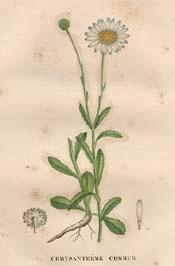
Botanical.com Home Page

|
Daisy, Ox-Eye
(Chrysanthemum leucanthemum)
Click on graphic for larger image
|
Daisy, Ox-Eye
Botanical: Chrysanthemum leucanthemum (LINN.)
Family: N.O. Compositae
---Synonyms---Great Ox-eye. Goldens. Marguerite. Moon Daisy. Horse Gowan. Maudlin Daisy. Field Daisy. Dun Daisy. Butter Daisy. Horse Daisy. Maudlinwort. White. Weed. Leucanthemum vulgare. (Scotch) Gowan.
---Parts Used---Whole herb, flowers, root.
The Ox-Eye Daisy is a familiar sight in fields. In Somersetshire there is an old tradition connecting it with the Thunder God, and hence it is sometimes spoken of as the 'Dun Daisy.'
It is to be found throughout Europe and Russian Asia. The ancients dedicated it to Artemis, the goddess of women, considering it useful in women's complaints. In Christian days, it was transferred to St. Mary Magdalen and called Maudelyn or Maudlin Daisy after her. Gerard terms it Maudlinwort.
The genus derives its name from the Greek words chrisos (golden) and anthos (flower), and contains only two indigenous species this and the Corn Marigold, in which the whole flower is yellow, not only the central disc of florets, as in the Daisy. The specific name of the Ox-Eye signifies 'white flower,' being like the generic name, Greek in origin. The old northern name for the Daisy was Baldur's Brow, and this, with many other species of Chrysanthemum became dedicated to St. John.
---Description---The plant generally grows from 1 to 2 feet high. The root is perennial and somewhat creeping; the stems, hard and wiry, furrowed and only very slightly branched. The leaves are small and coarsely toothed; those near the root are somewhat rounder in form than those on the stem, and are on long stalks, those on the stem are oblong and stalkless.
By the middle of May, the familiar yellowcentred white flower-heads commence to bloom, and are at their best till about the close of June, though isolated specimens may be met with throughout the summer, especially where undisturbed by the cutting of the hay, as on railway banks, where the plant flourishes well. Beneath each flower-head is a ring of green sheathing bracts, the involucre. These not only protect and support the bloom, but doubtless prevents insects trying to bite their way to the honey from below. They, as well as the rest of the plant, are permeated with an acrid juice that is obnoxious to insects.
The young leaves are said to be eaten in salads in Italy. According to Linnaeus, horses, sheep and goats eat the plant, but cows and pigs refuse it on account of its acridity.
[Top]
---Part Used Medicinally---The whole herb, collected in May and June, in the wild state, and dried. Also the flowers.
The taste of the dried herb is bitter and tingling, and the odour faintly resembles that of valerian.
---Medicinal Action and Uses---Antispasmodic diuretic, tonic. Ox-Eye Daisy has been successfully employed in whooping-cough, asthma and nervous excitability.
As a tonic, it acts similarly to Chamomile flowers, and has been recommended for nightsweats. The flowers are balsamic and make a useful infusion for relieving chronic coughs and for bronchial catarrhs. Boiled with the leaves and stalks and sweetened with honey, they make an excellent drink for the same purpose. In America, the root is also employed successfully for checking the night-sweats of pulmonary consumption, the fluid extract being taken, 15 to 60 drops in water.
Externally, it is serviceable as a lotion for wounds, bruises, ulcers and some cutaneous diseases.
- Gerard writes:
- 'Dioscorides saith that the floures of Oxeie made up in a seare cloth doe asswage and washe away cold hard swellings, and it is reported that if they be drunke by and by after bathing, they make them in a short time wellcoloured that have been troubled with the yellow jaundice.'
- Culpepper tells us that it is 'a wound herb of good respect, often used in those drinks and salves that are for wounds, either inward or outward' . . . and that it is 'very fitting to be kept both in oils, ointments, plasters and syrups.' He also tells us that the leaves bruised and applied reduce swellings, and that
- 'a decoction thereof, with wall-wort and agrimony, and places fomented or bathed therewith warm, giveth great ease in palsy, sciatica or gout. An ointment made thereof heals all wounds that have inflammation about them.'
Country people used formerly to take a decoction of the fresh herb in ale for the cure of jaundice.
Common Name Index
A MODERN HERBAL Home Page
Bear in mind "A Modern Herbal" was written with the conventional wisdom of the early 1900's. This should be taken into account as some of the information may now be considered inaccurate, or not in accordance with modern medicine.
© Copyright Protected 1995-2025 Botanical.com
|

